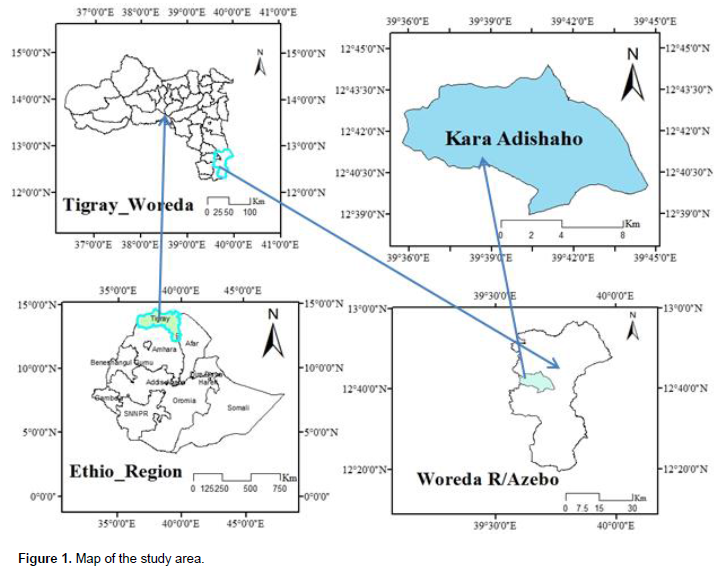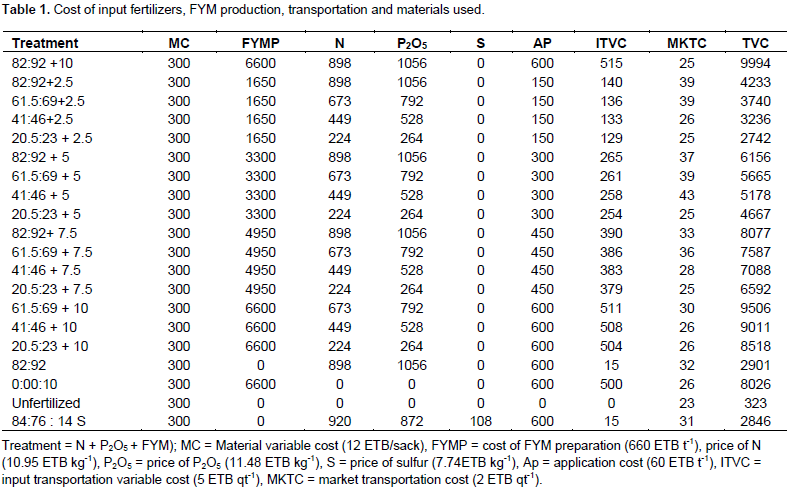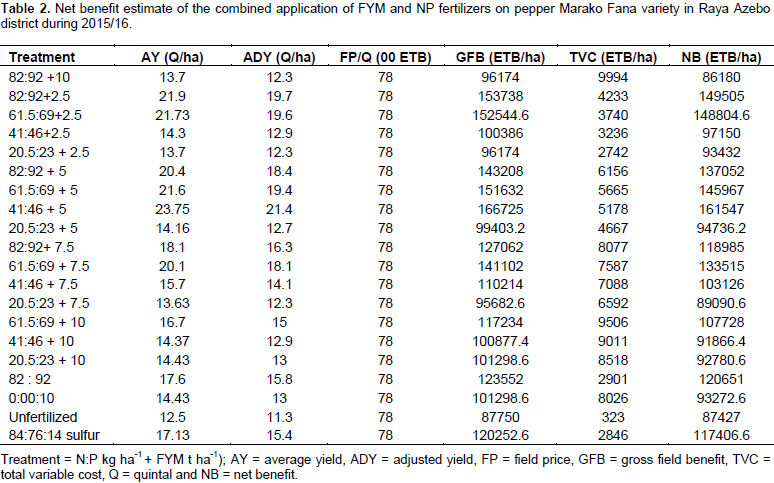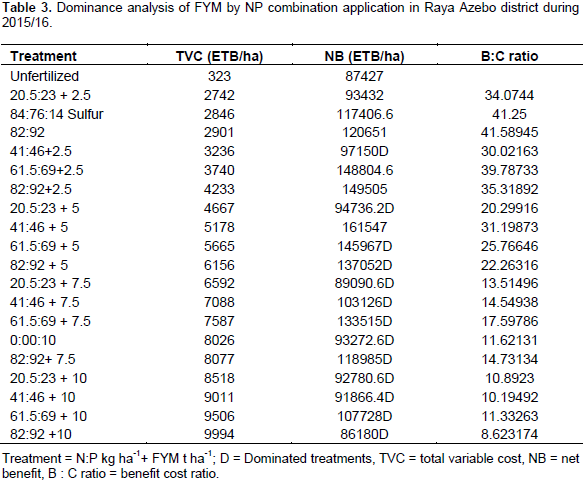ABSTRACT
This research was conducted to assess the economic feasibility of inorganic fertilizer application and farmyard manure on Marako Fana pepper variety in Raya Azebo district, Northern Ethiopia. The combination of 25, 50, 75 and 100% of nationally recommended inorganic fertilizers and 10 t ha-1 farmyard manure as well as four control treatments (unfertilized, 100% farmyard manure, 100% and blended fertilizer/NPS) were used in this study. The experiment was laid out in a randomized complete block design with three replications. The application of half rate recommended inorganic fertilizer in combination with 5 t ha-1 farmyard manure produced significantly, the maximum total and marketable dry fruit yield of 2.495 and 2.375 t ha-1. Moreover, this treatment was also better than other treatments and generated above the minimum acceptable marginal rate of return. Therefore, it could be concluded that this fertilizer rate could be used in the study area for the production of the variety under irrigation. Hence, to obtain optimum economic return from the production of pepper at the study area, it is recommended to apply an integrated fertilizer management approach.
Key words: Blender fertilizer, marginal rate of return, NP, partial budget.
Abbreviation:
FYM, Farmyard manure; RNPR, recommended nitrogen and P2O5 rate; NP, recommended NPS rate; RCBD, randomized complete block design.
Partial budget analysis (PBA) provides useful information for making decisions. Partial budget analysis can be used for comparing the impact of a technological change on farm costs and returns (International Potato Center, 1982). The partial budget measures the positive and negative effects of a change in the business. The left side of partial budget shows the positive effects on net income including additional income and reduced costs. To counter balance this positive effect, the right side includes reduced income and additional costs or the negative effects of the proposed change (Lessley et al., 1991). New technology can be evaluated in terms of its impact on the productivity, profitability, acceptability and sustainability of farming systems (Herdt, 1987). The profitability of hot pepper production is partly related with the right type of input (fertilizer and improved variety) usage and the cost incurred for these inputs (Amare, 2010). Partial budget analysis is a simple but effective technique for assessing the profitability of new technology for an existing enterprise. It also provides the foundation for comparing the relative profitability of alternative treatments, evaluating their riskiness, and testing how robust profits are in the event of changing product or input prices. Economic analysis is conducted to assess the feasibility of the treatments using partial budget, dominance and marginal analysis of each treatment. Partial budget analysis is used to organize experimental data and information on the costs and benefits of various alternative treatments. The partial budget included the average yields for each treatment, the adjusted yields, the gross field benefit and the total costs that vary.
The total costs which vary are the sum of all cost for alternative treatments. The increased production of the crop due to the application of inputs might or might not be beneficiary to farmers. Therefore, partial budget analysis (CIMMYT, 1988) should be employed to estimate the net benefit and marginal rate of return that could be obtained from various alternative treatments. Summer chilling is the major problem in Raya Azebo district. Due to this, rain-fed pepper production in the study area is impossible. Once chilling occurs, it affects the pepper plant at any stage of growth. Consequently, both dry and green pod pepper in the area is produced in irrigation season. Not only this, most of the pepper research done in the study area has focused on production issues, but almost none on other pepper economic aspects. Therefore, the purpose of this study was to identify the best pepper production option from different technological package alternatives and recommend those that would meet socio-economic conditions of farmers. It is indeed assumed that some of the pepper technological packages are more profitable than the current farmer pepper production practices. The specific objectives of the study are:
1. To assess the economic feasibility of NP and farmyard manure fertilizers application on Marako Fana pepper variety.
2. To identify the profitable hot pepper production package among alternative treatments
Description of the study area
This study was conducted in Raya Azebo Wereda, northern Ethiopia. The specific site of the research was in lowland area of Raya Azebo Wereda, particularly at Kara Kebele (Figure 1). Raya Azebo Wereda is located in 12°3’-13°7’N latitude and 39°5’-39°8’E longitude. Agro-climatically, the area is characterized as dry semi-arid climate (Araya et al., 2010). The mean annual temperature and mean annual rain fall ranges from 16 to 28°C and from 446 to 830 mm, respectively. Various soil types commonly found in the area include verti soils, nitisoil, combisols and luvisols. Vertisoil (black soil with swalling characteristics) is the dominant soil types, which cover over 70% of the study area (Raya Azebo Wereda ARD Office, 2016).

Treatments and experimental design
The study was executed under irrigation using a pepper variety known as Marako Fana. This variety is widely adapted and recommended hot pepper in the study area. The seeds of Marako Fana were obtained from Alamata Agricultural Research Center and sown in 15 cm rows in a nursery established on well prepared seed bed. Sufficient numbers of seedlings were raised for the field experiment. The national recommended inorganic fertilizer application rates of 82 kg N ha-1 + 92 kg P2O5 ha-1 for the crop and 10 t ha-1 FYM, considered as optimum organic fertilizer rate for vegetables, were the basis for arranging the combined fertilizer treatments. Taking the application of the inorganic and organic fertilizers rates in combination as maximum, the treatments were arranged as 100, 75, 50 and 25% of these rates in all possible combinations. Application of the national recommended inorganic fertilizer rates, 10 t ha-1 FYM, blended fertilizer recently recommended for DAP with recommended urea (200 kg NPS ha-1 + 100 kg urea or 84 kg N ha-1 + 76 kg P2O5 ha-1 + 14 kg sulfur ha-1) and no fertilizer application, were considered as control treatments. The blended fertilizer was used as control treatment since Bureau of Agriculture and Rural Development (BoARD) is distributing NPS in place of DAP. In this study, TSP and urea were used as source of P2O5 and N, respectively. The field experiment was laid out as randomized complete block design (RCBD) with three replications. A spacing of 30 and 70 cm between intra and inter-row, respectively, was maintained. There were six rows per plot and 15 plants per row with a total of 90 plants per plot in a plot size of 4.5 m × 4.2 m in length and width, respectively. Plants in the two rows at the extreme end of both sides of each plot and the two plants at the end of each row were not considered as experimental plants. This gave the net plot size of 3.9 m × 2.8 m (10.92 m2) with a total of 52 plants per net plot. The spacing between blocks and plots was 1.5 and 1 m, respectively.
Experimental procedures
The farmyard manure (FYM) was produced in a trench under shade to avoid evaporation loss of nutrients. The FYM was decomposed for about six months following standard procedures. All available litter and refuse was mixed with dung then placed in the trench. A section of the trench from one end was used for filling with daily collection of three consecutive days. When the section is filled enough, the top of the heap was made into a dome and plastered with dung earth slurry. After two months of decomposition, the FYM was transferred into other well prepared trench early in the morning. Then later, it was left for decomposition for about four extra months. Seeds of Marako Fana were sown in November 01, 2015 on a seedbed size of 1 m × 10 m. In the nursery, 92 g/bed based P2O5 was applied in a bed during sowing time. The beds were then covered with dry grass mulch until emergence and watered using watering cane as needed. After seedlings emergence, the mulch was removed and then beds were covered by raised shade to protect the seedling from strong sunshine until eight days remained for transplanting. During hoeing and thinning of the seedlings, 82 g/bed based urea was applied in order to maintain optimum plant population and to keep seedlings vigorous. Watering was done with a fine watering cane in which the frequency was different depending on the seedling stages and seed bed was hand weeded. Other pertinent agronomic and horticultural practices were applied.
The seedlings were transplanted to the field when the seedlings attained 20 to 25 cm height. The layout of experimental units was done before a month (30 days) before seedlings were transplanted in November 15, 2015. Then later, the applications of FYM to experimental units was done on plots that received FYM as sole or in combination of inorganic fertilizers depending on the treatments and randomization made by lottery method. During farmyard manure (FYM) application, they were broadcasted in plots one month (30 days) before seedlings were transplanted. The FYM was mixed with soil by hand hoeing of each experimental unit. Transplanting was done in December 16, 2015. Refilling of dead seedlings in the field was done one week after transplanting on the place where the first seedlings were planted. All rates of P2O5 and half rates of nitrogen of the treatments were applied during transplanting, while half of nitrogen rates were applied after 30 days of transplanting. Experimental units were irrigated using boarder irrigation method in each plot and row in plots received water from the source without passing any of the experimental plot to prevent mixing of fertilizer given to different plots. Irrigation water application was at field capacity every four days for 15 days after transplanting and every week and 15 days depending on the growth stage of the plants and weather conditions. Other agronomic practices such as weeding, hoeing, etc were applied based on the crop’s requirement. Therefore, pods were harvested when they started drying and looked leathery (subjectively) in appearance on the plant. All treatments except unfertilized plot (2.33 times) were harvested three times. After harvesting, pods were further dried in partial shade until delectation.
Methods of partial budget analysis
Three analytical tools were used to identify the technological packages that are not only profitable but also exhibit good margin and remain profitable in different situations of input and output prices, respectively. Partial budget analysis was first carried out and generated the net benefits of the alternatives under study. It was then followed by marginal analysis which compares net benefits with partial budget by considering the magnitude of corresponding variable costs.
Data collection
Data were collected for the following parameters:
Gross average fruit yield (t/ha) (AvY): An average yield of each treatment converted in hectare base. Adjusted yield (AjY): Average yield adjusted downward by 10% to reflect the difference between the experimental yield and yield of farmers thus: jY (t/ha) = AvY × (1-0.1). Gross field benefit (GFB) (ETB/ha): Computed by multiplying field/farm gate price (quintal/ha) by adjusted yield thus: GFB = AjY × field/farm gate price for the crop. Total variable cost; cost of fertilizers and FYM preparation used for the experiment. The costs of other inputs and production practices such as labor cost for land preparation, planting, weeding, crop protection, and harvesting was considered to remain the same or will be insignificant among treatments. Net benefit (NB) (ETB/ha): Calculated by subtracting the total costs from gross field benefits for each treatment thus: NB = GFB - total cost. Marginal rate of return (MRR %); calculated by dividing change in net benefit by change in cost (CIMMYT, 1988) thus:

Material costs, farmyard manure preparation costs as well as other input and transportation costs that vary are presented in Table 1. Adjusted yield of the crop is considered for partial budget related things as indicated by CIMMYT (1988) that adjustments between 5 and 30% are appropriate for partial budget analysis. The dry pod yield of pepper was reduced to 10% for agronomic recommendation for farmers.

Partial budget analysis
This economic analysis is based on the average yield of each treatment across all repetitions (Duncan et al., 1990). Therefore, the net benefit estimate for 20 treatments is presented in Table 2. The application of 41 kg N ha-1 + 46 kg P2O5 ha-1 in combination with 5 t FYM ha-1 had a total net benefit of 161,547 ETB followed by 82 kg N + 92 kg P2O5 ha-1 and 61.5 kg N + 69 kg P2O5 ha-1 both in combination with 2.5 t FYM ha-1 which also had a total of 149,505 and 148,805ETB net benefit, respectively. Furthermore, the later inorganic fertilizers combination with 5 t FYM ha-1 also had higher net benefit of 145,967 ETB. The lowest net benefit was obtained by the application of the highest rates of fertilizers application (82 kg Nha-1 + 92 kg P2O5ha-1 + 10 t FYM ha-1) with a total of 86,180 ETB followed by the net benefit obtained from production of pepper without fertilizer and by application of 20.5 kg N ha-1 + 23 kg P2O5 ha-1 + 7.5 t FYM ha-1 with net benefit of 87,427 and 89,090.6 ETB, respectively. The low net benefit obtained might be due to low yield coupled with high cost prevailing treatment combinations. The profitability study showed that application of 41 kg N ha-1 + 46 kg P2O5 ha-1 in combination with 5 t ha-1 FYM which provided the highest net benefit (161,547 ETB), was the peak to apply fertilizers. This indicated that the total costs increased until a certain level, and the net benefit obtained increased. However, as the total costs that vary increased over the optimum level, the net benefit obtained reduced as a result of higher variable costs associated with lower earnings. Similarly, the result of nitrogen experiment in maize presented by CIMMYT (1988) with application of 40, 80, 120 and 160 kg N ha-1 showed increase of net benefit until increase in the level of investment of up to 80 kg N ha-1 and reduced net benefit after application.

Dominance analysis and net-benefit curve
In most cases, farmers prefer the highest profit (low cost with high income). For this purpose, it is necessary to conduct dominated treatment analysis. A dominated treatment is any treatment that has net benefits that are less than those of a treatment with lower costs that vary (Stephen and Nicky, 2007). The dominance analysis procedure as detailed in CIMMYT (1998) was used to select potentially profitable treatments from the range that was tested and serve to eliminate some of the treatments from further consideration and thereby simplify the analysis. The dominant (undominated) treatments were ranked from lowest to highest costs that vary. The net benefit curve also clarifies the reasoning behind the calculation of marginal rates of return, which compare the increments in costs and benefits between such pairs of treatments. The net benefit curve indicated that as the cost increases from lowest to small increase of 5000 ETB, the net benefit also increased linearly and attained peak at 5178 ETB. Thereafter, the net benefit reduced as the cost increased. The dominant analysis showed that the net benefit of all treatments were dominated except unfertilized plot and application of 20.5 kg N ha-1 + 23 kg P2O5 ha-1 + 2.5 t FYM ha-1 and nationally recommended inorganic fertilizers, application of blended fertilizer (84 kg N ha-1 + 76 kg P2O5 ha-1 + 14 kg sulfur ha-1), the two higher rates of inorganic fertilizers (82 kg N+92 kg P2O5 and 61.5 kg N + 69 kg P2O5 ha-1) both combined with low rate of 2.5 t FYM ha-1 and 41 kg N + 46 kg P2O5 + 5 t FYM ha-1 (Table 3). This result indicated that the net benefit decreased as the total cost that varies increased beyond undominated fertilizer treatments application. Therefore, no farmer may choose other dominated treatments in comparison with the undominated treatments. This also helps in avoiding the dominated treatment for further estimation of marginal rates of return.

Marginal rate of return
The net benefit-cost ratio showed that as the cost is one birr, the net benefit ranged from 31.2 to 41.6 birr for the dominant treatments. For each pair of ranked treatments, a % marginal rate of return (MRR %) was calculated. The % MRR between any pair of dominant treatments denotes the return per unit of investment in fertilizer expressed as a percentage. This analysis was conducted and presented in Table 4 and Figure 2. As shown in Table 4, the result of analysis of dominant treatments indicated that for each one birr invested in purchase or production of fertilizers, it was possible to recover one birr plus an extra 2.48, 230.53, 58.99, 33.56, 1.42 and 12.74 birr/ha as the fertilizer application changed from unfertilized plot until supplementation of 41 kg N ha-1 + 46 kg P2O5 ha-1+5 t ha-1 FYM, respectively. From the time of the first treatment that had the lowest costs to the end of the treatment which had the highest cost, that varies, the marginal rate of return obtained was above the minimum acceptable marginal rate of return. Accordingly, the study revealed that application of 41 kg N ha-1 + 46 kg P2O5 ha-1 + 5 t ha-1 FYM was the best recommendation.


The best recommendation for treatments subjected to marginal rate of return is not (necessarily) based on the highest marginal rate of return, rather, based on the minimum acceptable marginal rate of return, and the treatment with the highest net benefit together with an acceptable MRR becomes the tentative recommendation (CIMMYT, 1988). The process of calculating the marginal rates of return of alternative treatments, proceeds in steps from the least costly treatment to the most costly, and resolves if they are acceptable to farmers, which is called marginal analysis (CIMMYT, 1988). One way of assessing this change is to divide the difference in net benefits by the difference in costs that vary (CIMMYT, 1988). Marginal rate of return is marginal net benefit (Stephen and Nicky, 2007). In this study, 100% was considered as minimum acceptable rate of return for farmers’ recommendation. It is important to note that the acceptable minimum rate of return for farmers’ recommendation is 50 to 100% (CIMMYT, 1988).
Pepper (Capsicum annuum L.) is the world’s most important vegetable after tomato. Both sweet and hot peppers are processed into many types of sauces, pickles, relishes and canned products. This study was conducted in Raya Azebo Wereda of Northern Ethiopia; specifically, Kara Kebele in 2015/16. It was executed under irrigation to assess the economic feasibility of NP and farmyard manure fertilizers application on Marako Fana pepper variety. The experiment was laid out as a randomized complete block design with three replications and treatments consisting of the combined application of four levels each for nitrogen, phosphorus and FYM. In this study, no fertilizer application, application of nationally recommended nitrogen and phosphorus rates, 10 t ha-1 FYM as well as NPS fertilizers were considered as control. The highest total dry fruit yield t ha-1 was obtained from plots that received inorganic and organic fertilizers combination. Similarly, the highest marketable yield (2.375 t ha-1) of Marako Fana was obtained on combined application of FYM which consisted of 50% of the blanket recommendation of inorganic fertilizers and 5 t ha-1 FYM.
The application of this treatment showed that about 1.125 t ha-1 more marketable yield than unfertilized plot. Most of the treatment combinations of inorganic and organic fertilizers produced almost thesame amount of unmarketable dry fruit yield except the highest and the lowest unmarketable dry fruit yield obtained from blended fertilizer and 41 kg N + 46 kg P2O5 + 2.5 t FYM ha-1 applications, respectively. In this study, partial budget analysis was also employed by considering total variable cost and net benefit, dominated and dominant treatments using dominance analysis, cost-benefit curve and marginal rate of return. The result indicated that the net benefit of all treatments except in the unfertilized plot. The combined application of half the nationally recommended rates of nitrogen, phosphorus and 5 t ha-1 FYM fertilizers was economically acceptable as compared to the other dominant treatments, although the marginal rate of return obtained from all dominant treatments was above the minimum acceptable marginal rate of return. Hence, to obtain optimum economic return from pepper production in the study area, it is recommended that 5 t ha-1 of FYM with half the rate of nationally recommended nitrogen and phosphorus fertilizers be applied. This recommendation is made based on varying total costs and marginal rate of return for alternative treatments.
The authors have not declared any conflict of interests.
The authors express their sincere appreciation to Capacity Building for Scaling up of Evidence-Based Practice in Agriculture Production in Ethiopia (CASCAPE) project for its full financial support. They also acknowledge Alamata Agricultural Research Center that provided the improved seeds of Marako Fana pepper variety.
REFERENCES
|
Amare T (2010). Determinants of Red Pepper Market Supply: The case of Jabitehinan Woreda, West Gojjam Zone of the Amhara National Regional State, Ethiopia. MSc Thesis Submitted to the Department of Agricultural Economics, Haramaya University, Ethiopia.
|
|
|
|
CIMMYT Economics program (1988). From agronomic data to farmer recommendations: An economics training manual. 27: CIMMYT.
|
|
|
|
|
Duncan B, Eric C, Mark K, Bruno H (1990). Economic analysis of on-farm trials: A review of approaches and omplications for research program design. Michigan State University, Senegal.
|
|
|
|
|
Herdt R (1987). Whither farming systems? In: how systems work. Proceedings of farming systems research symposium, University of Arkansas pp. 3-7.
|
|
|
|
|
International Potato Center (1982). Partial Budget Analysis for on-farm potato research. Lima, Peru.
|
|
|
|
|
Lessley B, Johnson D, Hanson J (1991). Using the partial budget to Analyze farm change. University of Maryland System 7:1990-1991.
|
|
|
|
|
Stephen K, Nicky M (2007). In service training on partial budgeting techniques. Mount Makulu, Lusaka, Zambia.
View
|
|